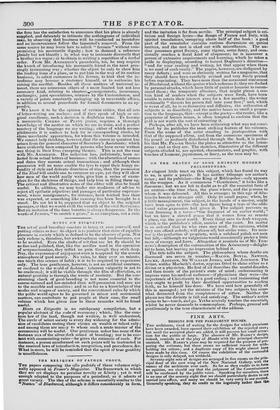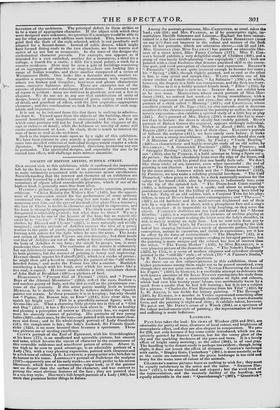FINE ARTS.
DESIGNS FOR THE PARLIAMENT HOUSES.
THE architects, tired of waiting for the designs for which premiums have been awarded, have opened their exhibition of the rejected ones; but until the accepted plans are added, it will possess but small attrac- tion for the public at large. The absence of Mr. BARRY'S design, indeed, reminds us of the play of Hamlet with the principal character omitted. Mr. BARRY'S plans may be required for the purpose of pre- paring the estimate, but there seems no sufficient reason for with- holding the others ; and a duplicate copy of his might almost have been made by this time. Of course the exhibition of the successful designs is only delayed, not withheld. Seventy-eight sets of designs are arranged in five rooms on the prin- cipal door of the east wing of the New National Gallery, with the names of the architects over each. So far as they enable us to form an opinion, we should say that the judgment of the Commissioners will be confirmed by the public voice. Speaking for ourselves, there is no one of the seventy-eight that we should particularly desire to see carried into effect, and many we should be very sorry to see erected. Generally speaking, they do credit to the ingenuity rather than tlitt!
invention of the architects. The principal defect in them strikes us to be a want of appropriate character. If the object with which they were designed were unknown. we question if a stranger would be able to say for what purpose such edifices were intended. This, however, is a good deal the fault of the style selected, which is not peculiarly well adapted for a Senate-house. Instead of noble domes, which might have formed fitting roofs to the two chambers, we have turrets and spires of no use but as ornaments. In the mass of the designs the ecclesiastical character prevails. For example, one appears as if intended for a vast cathedral, another for a monastery, a third for a college, a fourth for a castle, a fifth for a royal palace, a sixth for a country residence. Here may be seen a pile of buildings consisting of an aggregation of churches or chapels,-here one looking like a range of Indian temples, and there another composed of a series of Westminster Halls. One looks like a fantastic dream, another re- sembles a stupendous toy. Some are monotonous with repetition, others too broken and irregular ; heaviness and gloom characterize some, excessive lightness others. There are examples too of the extreme of plainness and redundancy of decoration. In several a want of repose is evident : many are deficient in grandeur, and not a few in elegance. We do not see in any one that combination of unity of design, beauty of proportion, harmony of parts, variety and richness of detail, and grandeur of effect, with the first requisite-appropriate character ; and this combination we look for in an edifice of such mag- nitude and importance.
It is not to be inferred from this that there is nothing to admire- far from it. Viewed apart from the objects of the building, there are several beautiful and magnificent structures; and there are few in which some portions will not be found admirable for elegance of de- sign or richness of detail ; while the boldness or novelty of some will excite astonishment at least. In short, there is much to interest the man of taste as well as the architect.
Such is the impression made upon us by a sight of this exhibition. We have been content to give merely a general opinion of it, for to enter into detailed criticism of individual designs would require a whole Spectator. We have purposely avoided, therefore, instancing any one in particular. The successful designs, and especially the one to be carried into effect, will challenge more minute attention.



























 Previous page
Previous page